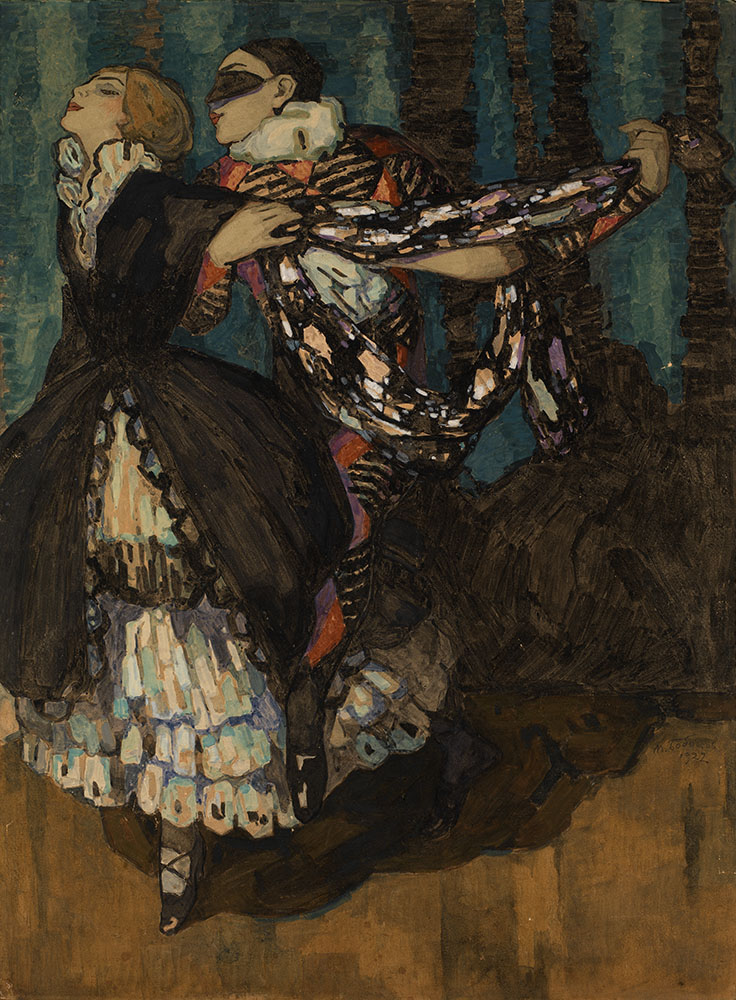26 November 2014 Russian Art Auctions
26 November 2014

76. BOBYSHOV, MIKHAIL (1885-1964)
Harlequinade, Michel and Vera Fokine in the Ballet "Carnaval", signed and dated 1922, also further signed three times, once with initials, inscribed with the artist’s address and “Pros’ba vstavit’ pod steklo/ i v ramu bol’shoi bronzy.”, titled in Cyrillic and variously numbered on the reverse.
Pencil, gouache and tempera on paper, laid on cardboard, 85 by 64 cm.
70,000-90,000 GBP
Provenance: Private collection, UK.
Exhibited: The Russian Art Exhibition, Grand Central Palace, New York, 1924.
23rd Annual Exhibition, Carnegie Institute, Pittsburgh, 24 April–15 June 1924 (label on the reverse).
Literature: I. Grabar, C. Brinton, The Russian Art Exhibition, Grand Central Palace, New York, 1924, No. 44, listed.
Exhibition catalogue, Twenty-Third Annual International Exhibition of Paintings, Pittsburgh, Carnegie Institute, 1924, listed.
Related literature: For similar work, see Grafika Russkikh Khudozhnikov ot A do Ya, Moscow, Slovo, 2002, p. 30.
The Russian Museum in St Petersburg has in its collections an oil painting from 1915 by Mikhail Bobyshov, Harlequinade, inspired by the one-act Diaghilev ballet, Carnaval, to the music of Robert Schumann, which was staged at the Mariinsky Theatre in 1910. The libretto was written by Leon Bakst and Mikhail Fokine, and the magnificent sets and costumes were also the work of Bakst. Bobyshov had been collaborating with the World of Art and showing his works at its exhibitions since the mid-1910s. Fokine was so impressed by Harlequinade, which depicts him and his wife Vera Fokine as Harlequin and Columbine, that he personally invited Bobyshov to work on the sets and costumes for the ballet entitled Eros, which was staged at the Mariinsky in 1915.
The watercolour-tempera version of Harlequinade, which is offered for auction, was painted by the artist in 1922 specially for the exhibition of Russian art in Pittsburgh, USA. Like most of Bobyshov’s works from the late 1910s and early 1920s, the picture combines the intense sensitivity of the late World of Art style with the artist’s unique mosaic technique, which is wonderfully suited to the theme. Despite the generality of the details, the silks and chiffons of the costumes are convincing and the slightly off-centre composition gives the work a graceful dynamism and musicality.
Many of Mikhail Bobyshov’s best works are now in the collection of the Russian Museum.
Notes on symbols:
* Indicates 5% Import Duty Charge applies.
Ω Indicates 20% Import Duty Charge applies.
§ Indicates Artist's Resale Right applies.
† Indicates Standard VAT scheme applies, and the rate of 20% VAT will be charged on both hammer price and premium.